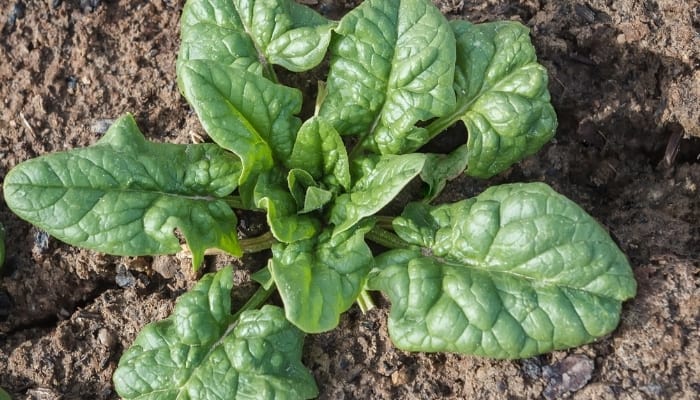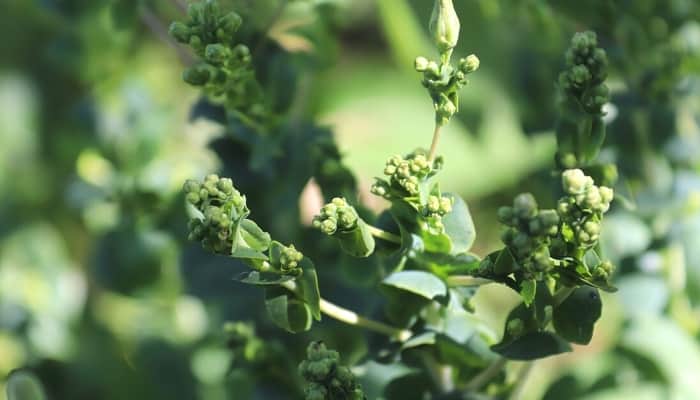If you cultivate vegetables in your garden, it is possible for them to occasionally bolt. Bolting is a phrase used to describe when a plant begins to bloom and produce seeds.
That’s often a problem since the tasty vegetables will become chewy and bitter once they bolt. Spinach is no exception.
How do I know if my spinach is bolting? When spinach bolts, its leaves change shape and look like arrowheads. A thick stalk develops out of the center of the plant as the whole plant grows taller. Then flowers will open on the stalk. These flowers will eventually dry out after pollination and produce seeds.
It can be quite tricky to provide the ideal growing conditions for your spinach patch and prevent it from bolting prematurely.
Continue reading to find out what it means if your spinach is bolting and how to prevent it from happening.
Spinach Bolting – What To Know
When spinach bolts in the garden, that usually signals the end of the delicious and succulent leaves and stalks.
The leaves turn sinewy and bitter, and the plant dedicates its resources to developing a long stalk with flowers.
What Does Bolting Spinach Look Like?
If you’re new to spinach growing, you might miss the first signs of bolting. These usually revolve around the leaves.
Instead of having rounded succulent leaves, the plant develops narrow leaves that look like arrowheads. Then a long stalk develops from the center of the plant. Overall, your spinach plant grows taller than usual.
The thick stalk continues to grow taller as the leaves grow smaller, and small flowers develop along the sides of the stalk.
By that time, the plant is no longer edible. The flowers will be pollinated and will fade, and seeds will develop in their place.
What Causes Spinach To Bolt?
If your spinach starts to bolt, you should look for the cause in the growing conditions around the veggie. Heat is the main cause of spinach bolting since this is a cool-season plant.
This is especially true if the weather temperature rises around the time the spinach reaches maturity.
Another cause of premature bolting is if the spinach plant is stressed because of too little water. If the plant is getting too much sun while also not getting watered regularly, this causes it to bolt.
When the plant senses unfavorable growing conditions, this triggers it to go to seed since that’s the ultimate goal of every plant.
Bolting Process
The bolting process in spinach starts with the leaves. Those round and meaty leaves suddenly shrink in size and become pointy like an arrowhead.
This is followed by a thick stalk growing out of the center of the plant. The longer it grows, the smaller the leaves become.
The spinach plant also starts to grow taller in general as the stems keep growing at the cost of the leaves. Once the main stalk reaches its full height, small flowers emerge along the sides.
The flowers will get pollinated and then fade, and seeds develop in their place. When the seeds mature, the plant will die having fulfilled its mission.
Can Bolting Be Stopped?
Once the bolting mechanism is triggered in the spinach plant, there’s no stopping it.
Bolting is a defense mechanism that causes the plant to dedicate its resources toward developing flowers and seeds to preserve the species.
There’s nothing you can do to stop or reverse this natural stage in the development of the plant.
Can You Eat Bolted Spinach?
Spinach is known for its juicy and succulent green leaves, but once the plant bolts, those tender leaves turn bitter and chewy.
You can’t cook them anymore, and if you do, the dish will be quite bitter. In general, bolting spinach has the texture and taste of kale without the health benefits.
Once your spinach bolts, either pull it out or leave it in the ground and harvest the seeds for next season’s growth.
What To Do When Spinach Goes To Seed
In general, there’s nothing you can do about bolting spinach. The process cannot be stopped. You have two options regarding the bolting plants.
You could let them continue to develop flowers and seeds. The seeds will come in handy the next time you want to plant spinach.
Since the plants tend to bolt so unexpectedly, I’d recommend planting a heat-resistant variety.
The other option is to pull the plants out and prepare the soil for another crop. The bolting plants can be fed into the compost bin or dried and used as mulch.
Spinach Growth Stages

Spinach, just like other vegetables in your garden, goes through various growth stages. Here’s the lowdown of these stages.
- Germination: Usually the seeds need between 5 and 9 days to germinate. Soil temperatures should be between 45 and 68℉ (7 to 20°C) and the soil needs to be kept moist until germination occurs. You may need to water twice a day.
- True Leaves: The first true leaves will emerge between 15 and 20 days after germination. These are the leaves developed from resources absorbed by the roots and not from the resources in the seeds.
- Thinning: Once the plant develops its second true leaf pair, you can thin the seedlings out. Thinning along with weeding improves the quality of the plant. Allow 4 to 6 inches of space between each plant.
- Third True Leaf: The spinach plant starts to develop quickly after 25 days from germination. When you see the third set of true leaves, that’s your cue to fertilize the veggie patch.
- First Harvest: It will take the spinach another 20 days to develop broad and round leaves that are ready for harvesting. Harvest the big leaves when the plant has developed at least six leaves in total.
- Full Harvest: Keep harvesting the mature leaves as long as the weather is cool. Once the temperature rises, the plant will bolt, so harvest the plants by pulling out the roots before they bolt.
Signs That Spinach Is Going To Bolt
You need to keep an eye out and look for the first bolting signs to save your spinach harvest. The first sign will usually be in the leaves.
Instead of growing round and broad, the leaves will shrink in size and take the shape of an arrowhead. You should harvest the spinach patch before that happens.
The next sign is the thick stalk growing at the center of the plant. By this time, there’s no saving the harvest, and you should just uproot the plants and prepare the soil for other plants.
Bolt-Resistant Spinach
Not all spinach varieties bolt easily even when they’re stressed with little water or too much sun. Here are some bolt-resistant varieties to consider:
- New Zealand Spinach: It takes this variety about 60 days to harvest. However, it has excellent heat resistance and can grow throughout the summer. Keep in mind that it’s not real spinach although it looks and tastes just like spinach.
- Bloomsdale Long Standing Spinach: Start this variety early in the spring to enjoy a few harvests before the weather warms up in the late spring. It often bolts when the temperature goes above 80℉ (26℃).
- Red Malabar Spinach: This is not real spinach and is better cooked. The vines are covered with lots of fresh leaves that resist heat and bolting.
When To Plant Spinach
When planting spinach, you should avoid the extreme heat of the late spring and summer. The best time to plant the veggie is in late winter or early spring.
Harvest regularly before the plant bolts. Another option is to plant it in the early fall after the weather has cooled down.
Tips To Delay Spinach Bolting
Try to plant the spinach as early as you can. Growing the plant in a cold frame is also a good idea, especially if the spring is short and turns hot quickly. A third option is to plant bolt-resistant varieties.
Harvesting Spinach
You should start harvesting spinach once the plant has six leaves reaching between 3 and 4 inches each.
Keep harvesting the developed leaves until the weather warms up. Then uproot the veggie in the final harvest.
Related Questions:
Is Perpetual Spinach Perennial?
Yes, perpetual spinach will keep growing leaves in the second year. However, the harvest in the second year is not as abundant as in the first year.
How Do You Get Seeds From Bolted Spinach?
Allow the flowers to be pollinated and fade. Seeds will develop out of the fading flowers. When the seeds mature, collect them and store them in a jar for the next season.
Conclusion
Spinach bolts when the temperature rises or the plant is stressed due to poor irrigation.
Bolting is a natural stage in the development of spinach, but the plant will produce abundantly before succumbing to warm temperatures.

